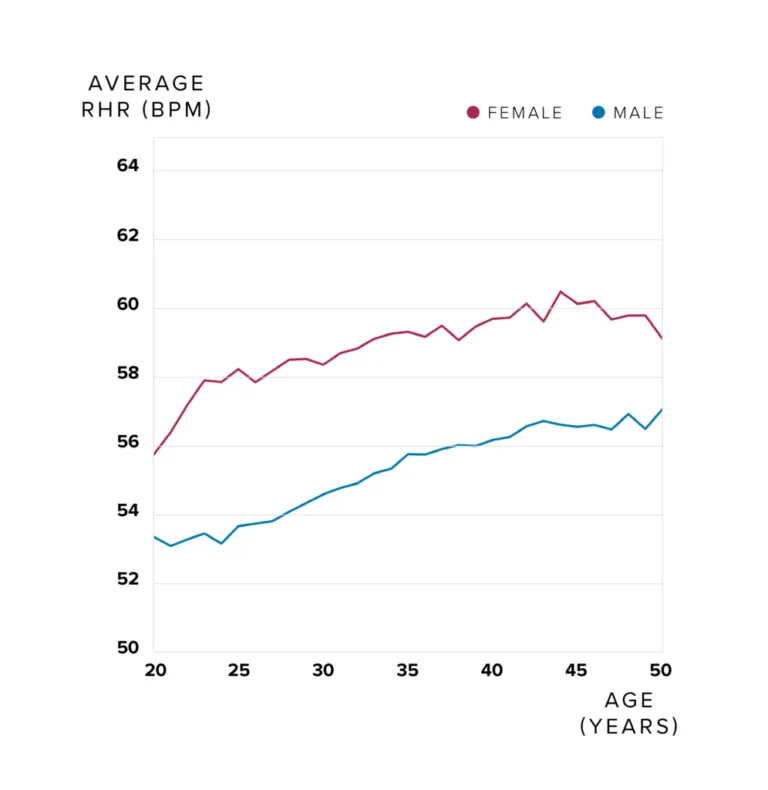Topics
- Article
- Heart Rate
Resting Heart Rate: What’s Normal, Why It’s a Sign of Fitness, How to Improve It

We’ll examine what is a healthy resting heart rate for men and women, what’s average or “normal” for both, and break it down by age.
What is Resting Heart Rate?
Resting heart rate (RHR) is a measure of your average heart beats per minute (bpm) while your body is in a state of complete rest. It is a very useful metric for monitoring your fitness level and overall health. Generally speaking, a lower resting heart rate is a good sign. Below we’ll examine what is a healthy resting heart rate for men and women, what’s average or “normal” for both, and break it down by age. We’ll also discuss why RHR is an indicator of your physical fitness, what you can do to improve it, plus the most reliable and effective way to track it.
Normal Resting Heart Rate
The American Heart Association states that a normal resting heart rate is usually between 60 and 100 beats per minute. However, for athletes and people who are active, this number may dip closer to 40 bpm. It’s also worth noting that the average resting heart rate for women tends to be a bit higher than for men. This is because females typically have slightly smaller hearts, which in turn produce less blood flow with each beat and must pump faster to reach the same output. Additionally, there is often a slight increase in RHR with age.
Average Resting Heart Rate Chart For Men & Women
What is a good resting heart rate by age and gender? The graphic below depicts the average resting heart rate by age for male and female WHOOP members between 20 and 50 years old.

the average resting heart rate for men wearing WHOOP is 55.2 bpm, and for women it’s 58.8 bpm.
Across all ages, the average resting heart rate for women wearing WHOOP is 58.8 bpm, and for men it’s 55.2 bpm. Given that our members tend to be athletes and/or people who are particularly interested in monitoring their health and well-being, it’s no surprise that the normal resting heart rate for men and women on WHOOP is below what the AHA considers average.
Why a Low Resting Heart Rate is a Sign of Fitness
To put it simply, “When your heart rate goes down, it means that each heart beat is more effective” (Podcast 29: HRV). A low resting heart rate is an indication of a strong heart muscle that can pump out a greater amount of blood with every beat so it does not have to beat as frequently. Your physical fitness is directly correlated to the strength of your heart. When your heart is in better condition and doesn’t need to work as hard to push blood throughout the body and deliver oxygen to your muscles, your fitness improves.
What Does a High Resting Heart Rate Mean?
Just as a low RHR is a sign of a stronger heart, a high resting heart rate may signify a weaker heart muscle. Research indicates that in the long-term, an elevated RHR likely adds to the risk of mortality. In the short-term, the following factors can increase resting heart rate:
- Strenuous exercise or overtraining
- Stress and anxiety
- Sleep deprivation and fatigue
- Dehydration
- Caffeine or alcohol consumption
- Smoking cigarettes or use of certain drugs
- Illness or underlying health conditions
- Medication side effects
However, having an above-average resting heart rate compared to others is not necessarily a cause for concern. A recent study showed that normal RHR from one individual to the next may vary by as much as 70 bpm.
How to Improve Resting Heart Rate
By far, the No. 1 thing to do for lowering resting heart rate is exercise. In particular, aerobic exercise like running or cycling (activities you can sustain for long periods of time at 70-80% of your max heart rate) will assist you in building cardiovascular strength. Additionally, each of the behaviors below can help you decrease your RHR:
- Getting all the sleep you need and improving the quality and consistency of your sleep
- Following a balanced diet with proper nutrition
- Hydrating sufficiently
- Avoiding alcohol
- Limiting stimulants like caffeine and nicotine
- Taking warm, calming showers or baths
- Going for walks outside, ideally in nature
- Relaxation exercises like guided breathing, meditation, stretching or yoga
In general, anything you can do to reduce stress and manage anxiety will benefit your resting heart rate.
Track and Measure Resting Heart Rate with WHOOP
Your heart rate fluctuates constantly and increases with activity, so accurately monitoring RHR on your own can be quite difficult — especially if you’re trying to track long-term trends and understand how they relate to your overall healthspan.
WHOOP measures your resting heart rate each night using a dynamic average weighted towards your last period of slow-wave sleep, when your body is in its most restful state. This ensures a highly controlled and reliable reading, allowing you to see how your cardiovascular efficiency evolves over time.
In the WHOOP app, you can view your RHR trends and use The Journal to note behaviors that may impact it. RHR is also a key contributor to your physiological age, and WHOOP integrates it into Healthspan—helping you quantify how your habits today may influence your long-term health.
Additionally, WHOOP factors in your RHR alongside heart rate variability, respiratory rate, and sleep performance to calculate your recovery each morning — so you know how prepared your body is to take on day.
WHOOP is not a medical device, our products and services are not intended to diagnose illness or any other health problems, and should not be used as a substitute for professional medical advice, diagnosis or treatment.